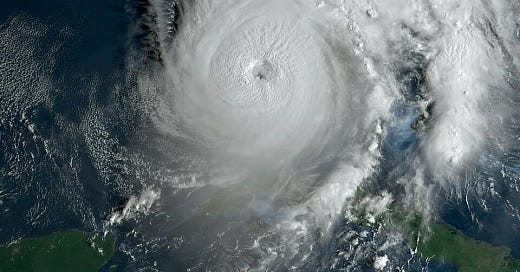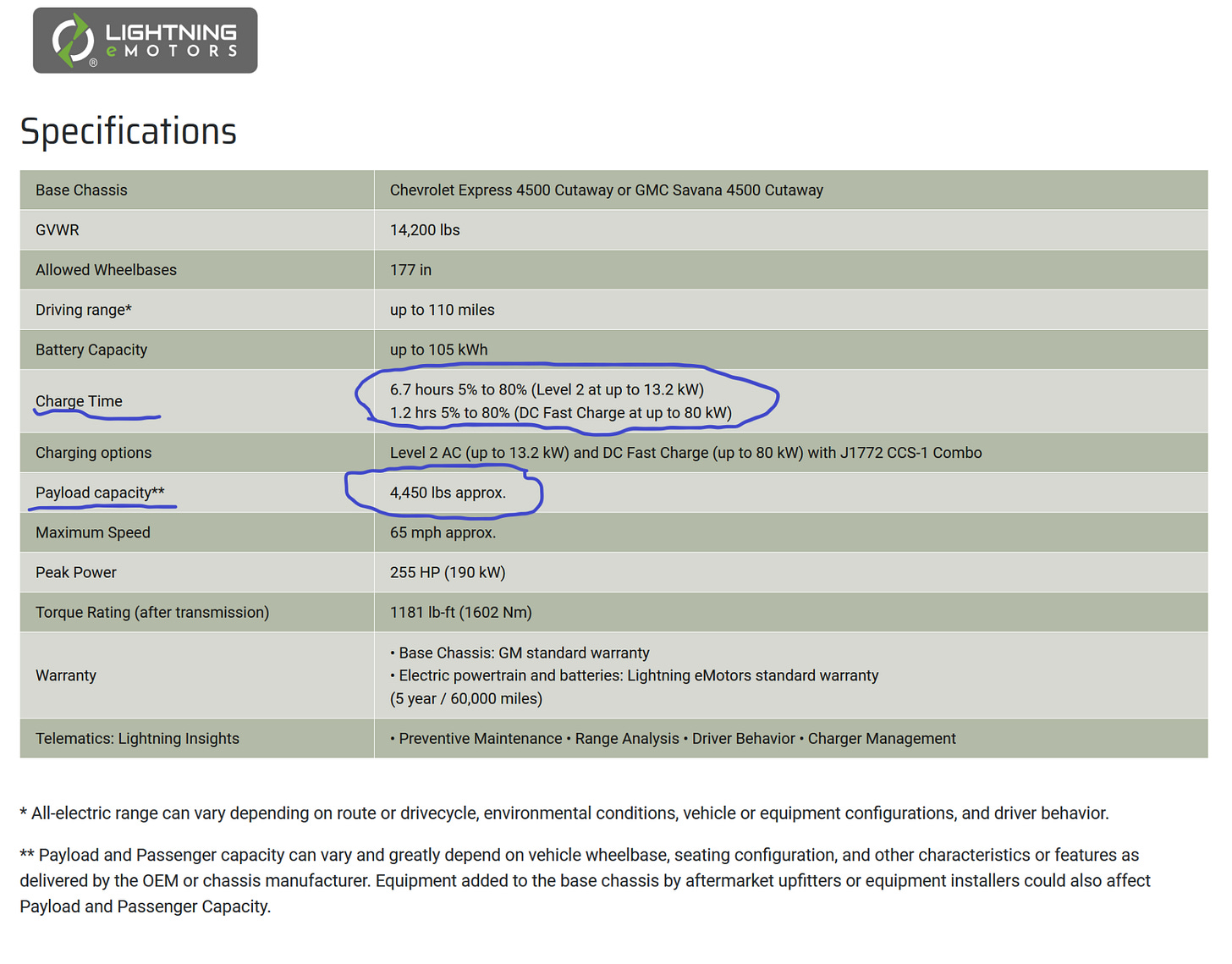Fuel Density For Disaster Recovery
After Hurricane Ian hit Florida in 2022, it took less than 3 weeks to rebuild a destroyed causeway to an island with ~6000 residents. That would have been impossible without energy-dense fuels.
Here is this article’s Big Question: Could we easily recover from hurricane damage if we relied on battery-electric construction equipment and vehicles?
Over the past few weeks, the Southeastern US was hammered by Hurricanes Helene and Milton. As the recovery work is still ongoing, we don’t yet know the full toll of the storms. As of now, the storms are reported to have claimed the lives of over 200 people and caused major damage to states including Florida, the Carolinas, and Georgia. Our thoughts and prayers are with those struggling to piece their lives back together.
If we look at storm recovery from an energy perspective, what is essential to getting help quickly to people in need?
To help answer that question, let’s take a trip back in hurricane history to September of 2022 when Hurricane Ian bore down on the Florida coastline. Below is a satellite image of that monster storm, credit the University of Wisconsin-Madison.
According to the National Oceanic & Atmospheric Administration, when Ian made landfall in Florida on September 28, 2022, the storm had maximum sustained winds speeds of ~ 150 miles per hour (~241km/hr).
The name Mother Nature is a bit misleading. “Mother” presents the image of nurturing and caring. And while nature can nurture us, the reality is that nature doesn’t give a thought about us humans and at times has no problem throwing all of her fury at whoever happens to be in her way. If a human mother treated us like ‘mother’ nature does, someone would probably call Child Protective Services and have us taken away. Just saying.
When Ian came ashore on the western coast of Florida, it devastated the Sanibel Causeway. The Causeway is a series of islands and bridges, providing the only driving-link and vital connection between the ~6000 person island community of Sanibel and mainland Florida. Ian’s winds and storm surges knocked out portions of the causeway, severing Sanibel’s connection to the mainland. Here is a picture from the Lee County Sheriff’s Office. The picture shows the devastation from the storm that carried off parts of the causeway island(s) and the roadway.
Yet despite the widespread destruction, 3 weeks after the storm made landfall, Governor DeSantis announced that construction crews finished temporary repairs and the causeway was re-open for business on October 19, 2022. While permanent repairs would take more time, the fact that Florida was able to reclaim land from the sea and repave roadways that quickly shows what America is still capable of achieving when we set our minds to it, coupled with government leadership that takes a pair of scissors to shred the red tape that usually surrounds construction projects.
The operation to re-open the causeway resembled a military amphibious operation landings on the beaches with a multi-pronged, nearly simultaneous attack from both the land and sea. Some of the work commenced on the land side of the causeway, while workers also sailed barges full of construction equipment, landing them on the disconnected causeway islands to begin work from those small islands before the land-based crews could effectively reach them.
The sheer complexity of the operation, involving the demolition of unusable sections of roadway, reclaiming land from the sea, rebuilding roadbeds and repaving a roadway in such narrow confines was achieved by working 24/7. The operation involved up to 1000 truck loads a day delivering a combined:
4000 tons of asphalt
8400 loads of fill
2400 loads of rock
While determined, organized, and streamlined leadership was paramount to achieve this success, none of this would have been possible without access to energy-dense fuels.
Energy density is simply how concentrated a fuel is. It matters when you’re trying to ship it, store it, and re-fuel.
It’s intuitive to understand: what’s easier to carry around? 10,000 pennies or a $100 bill? Yes, pennies still have a role to play, but if you need to transport a lot of money without having to push a wheelbarrow around, what do you want? And what is faster to use in a transaction? Count out all the pennies or pay with the bill?
It’s a similar story with energy.
Let’s compare some of the latest Tesla vehicle batteries - 4680 batteries - to diesel. We’ve been building batteries for generations. And despite the massive government taxpayer handouts and all of the chemical engineering, we don’t have a commercially available battery that is anywhere close to matching diesel’s storage capacity. Diesel holds approximately 44-46 units (MJs) of energy per Kilogram of weight. In comparison, a Tesla battery of the same weight might only hold around 0.9 units of energy (MJ/KG). That’s because a battery uses metals to chemically rival the energy storage that occurs naturally in the hydrogen and carbon bonds found in oil.
Yes, electric motors are more efficient than diesel engines. Let’s give an electric motor a 90% energy efficiency (including the conversion from the battery’s chemical storage to electricity, and then from electricity to work). And to be generous to the batteries, we’ll use an extremely low energy efficient diesel engine with 30% efficiency. Modern diesels can often get 35%-45%+ engine efficiency. Cummins even has a new diesel engine with heat recovery that theoretically can reach 55% efficiency. So, we’re basically making diesels look really bad by using only 30% efficiency in this comparison.
After adjusting for the different engine efficiencies, diesel fuel packs ~14x as much energy as a battery of the same weight, even if we use an old, lower efficiency diesel engine. Or if you want the same amount of energy, you’ll need a lot more battery. For instance, 7 or 8 lbs of diesel gets you the same amount of work that ~ 100+ lbs of batteries gives you, and that’s being generous to the battery. If we used a modern highly efficient engines, the comparison becomes even more ridiculous.
Now, this fuel density alone points out the massive physics challenges (or pure lunacy) of electrifying most construction and trucking fleets without leaps and bounds in battery technology that as of now, aren’t even on the horizon.
Let’s get specific. While you can get all sorts of dump truck variations, within the same model you can usually pick from a range of different sized fuel tanks, ranging from a small 50 gallon tank up to 250- 300 gallon tanks.
If you wanted a dump truck with a 200 gallon tank, the diesel fuel would weigh somewhere in the ballpark of 1400-1500lbs, plus the tank. But if in theory you could find a battery-dump truck with the same energy storage as a 200 gallon tank, the battery would weigh in around 20,000 lbs. That’s a problem if the truck is only designed to carry a max of maybe a 30,000lbs or 40,000 payload. That battery weight alone wipes out a massive chunk of your ability to move dirt, destroying whatever gains you got from the ‘electric’ motor’s efficiency.
To understand why, it’s simple: if you need a few tons of batteries, you can’t move as much dirt per a trip. That extra battery weight isn’t ‘free’ weight you can just tack on and still have the same carrying capacity. That means more hours, more trips, and potentially, overall less energy efficiency OR you’d go with a smaller, lighter battery which means more down time charging. The other option is you simply have a fleet of batteries and keep swapping them out.
Here’s a chart to visualize the problem. If you want a battery that stores the equivalent of 50 gallons, you might need around 5000 pounds of batteries. A 250 gallon battery-equivalent puts you at 25,000 lbs.
And then there’s refueling. How long does it take to pump 10 or 20 gallons of diesel? Maybe a few minutes. What about the time it takes to charge a battery with a 10 or 20 gallon equivalent battery? Humm…
Let’s look at a company that designs electric dump trucks, Lightening Motors, and their battery electric dump truck.
Now there might be a time and place for such a truck. But what if that was the backbone of your post hurricane recovery landing force to rebuild a causeway? Let’s look at the details - the devil is always in the details! Pay special attention to the load capacity and the charge time. With a fast charger, you can get an 80% charge in 1.2 hours! And with a max range of 110 miles on a full charge, an 80% charge gets you just under 90 miles!!!
Even if you could get 2 hours of work out of that truck, that means you’d need 1 charger for every 2 or 3 trucks and each truck would be down charging for a large portion of the time.
Now, in all fairness, batteries will progress in charging speeds, such as the Chinese Lithium Iron batteries. But a trade-off with those rapid charging speeds is a reduced battery lifespan, an inconvenient trade-off to say the least.
However, it doesn’t matter how fast the battery can theoretically charge, how do you charge them? Hurricane Ian knocked the power grid out, leaving millions without power and light. Two days after the storm made landfall in Florida, NASA flew an infrared satellite over the devastation and you can clearly see the difference before and after the storm. In the pictures, you can see part of Sanibel Island and what you can see of the Island is pretty dark after the storm.
When it comes to energy density, each logistical inefficiency compounds with the others, magnifying the problems:
Heavy batteries means less payloads per truck which means more trucks
Charging time means more down time per each truck
Slow charging means a vastly increased scale of refueling infrastructure. Instead of 1 diesel pump for every 10, 20 or 30 trucks, you might need 1 charger for every 2 or 3 trucks.
What could power a vast network of charging stations? Diesel generators?
In the wake of such a disaster, it’s not just the infrastructure and the equipment needed for one causeway project. Zoom out a little and you’ll see we need readily available machines by the thousands to rebuild the roads and restore power for an entire region. Without easily-accessible, energy-dense fuels that are simple to store and ship, we would not have the flexibility to quickly respond to a natural disaster in the way that Florida did after Hurricane Ian wiped out the Sanibel Causeway in 2022.
As a bonus, below is a video summary of the causeway repairs. Plus, click here to view a 2024 presentation by the Wisconsin Transportation Builders Association detailing how Florida quickly rebuilt the causeway. It’s a nice reminder of what Americans can still do under good leadership.
That’s all for now! Thanks for reading!











Such a good description of the benefits of energy density and the need for fuels of that nature to ensure society can function effectively.
I have been clearing snow all week. At least one hour a day for the last five days. I'm using a 1980 Allis 5050 with a 3 cylinder diesel engine. 750 ft of laneway and a large parking area. We've had about 3.5ft of snow this week. I haven't used 5 gallons fuel yet, for a 10 thousand pound tractor pushing a foot of heavy wet snow. There is no comparison.